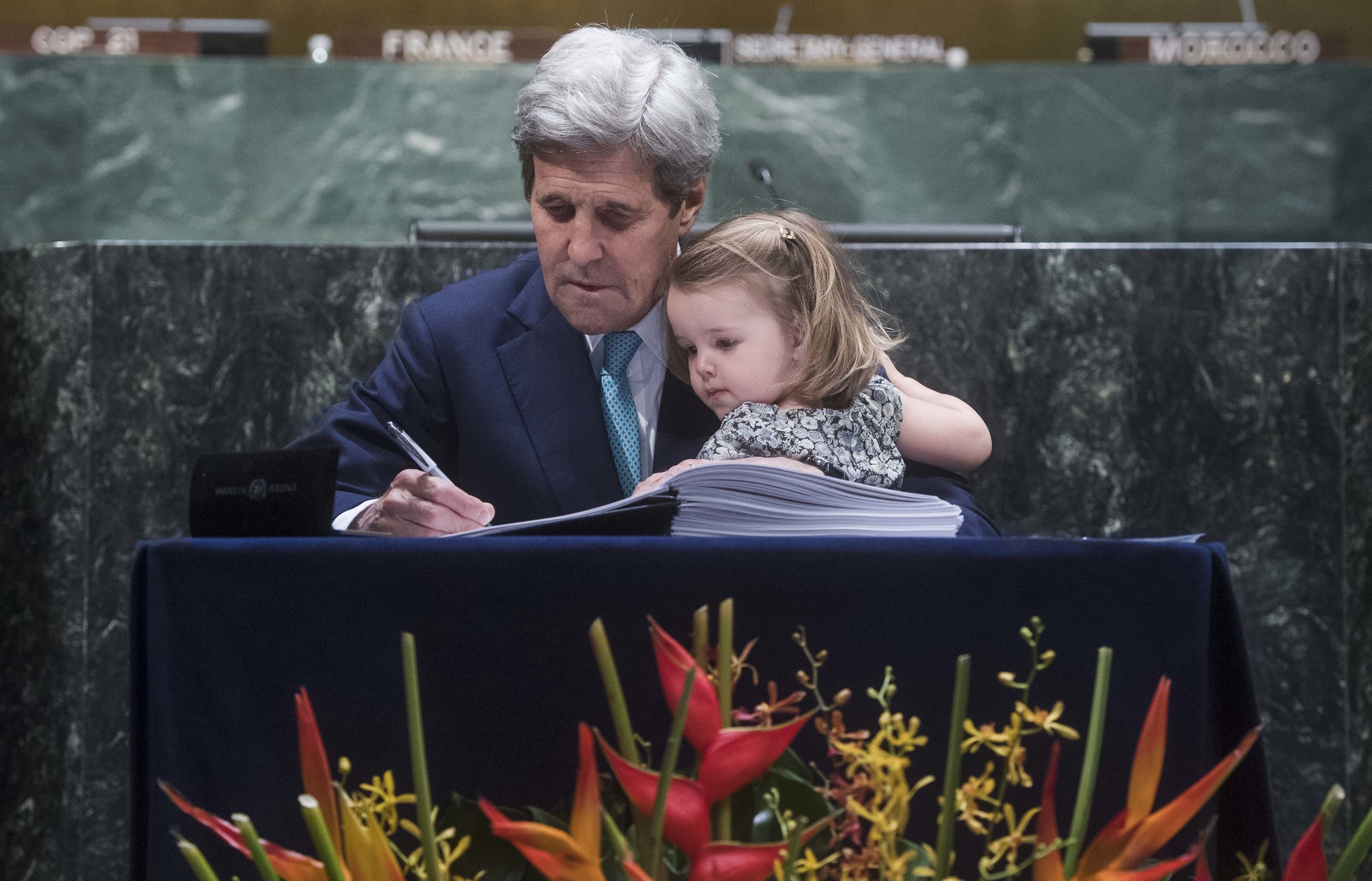The Biden Administration and International Climate Change Policy and Action
President-elect Biden is expected to initiate the process of rejoining the Paris Agreement on Inauguration Day. But the hard part will be coming up with a quantitative statement of how and by how much U.S. emissions of greenhouse gases will be reduced over time.

Published by The Lawfare Institute
in Cooperation With

On Jan. 20, Joe Biden will be inaugurated as the 46th president of the United States. He will face an unprecedented set of challenges, including global climate change—one of four stated policy priorities of his administration (along with the coronavirus pandemic, economic recovery and racial equity)—in addition to the immediate issue of the looming Senate trial of President Trump and ongoing threats of violence from extremist supporters. Because climate change is a global commons problem and international cooperation is necessary to limit free-rider incentives, President-elect Biden has pledged to immediately initiate the process of rejoining the Paris Agreement (from which President Trump withdrew the United States on Nov. 4, 2020—the earliest date permitted by the agreement). Thirty days after the necessary paperwork is filed with the United Nations, the United States will again be a party to the agreement. That’s the easy part. The hard part is coming up with a quantitative statement of how and by how much U.S. emissions of greenhouse gases will be reduced over time.
To fully appreciate the challenge the new administration will face, it is helpful to reflect on the history of international negotiations that brought us to this point. At the Earth Summit in Rio de Janeiro in 1992, the U.N. Framework Convention on Climate Change (UNFCCC) was first negotiated, committing parties to achieve stabilization of greenhouse gas concentrations in the atmosphere at a level that would “prevent dangerous anthropogenic interference with the climate system.” Three years later in Berlin at the first annual Conference of the Parties, it was agreed that the wealthier countries (listed in UNFCCC Annex I) would commit to targets and timetables for emission reductions, but not the other 129 (largely developing) countries. This was an attempt to provide for distributional equity among nations —recognizing that the industrialized countries were responsible for the lion’s share of accumulated greenhouse gases in the atmosphere, and by virtue of their wealth were more capable of taking action. Two years after that, in 1997, the Kyoto Protocol was enacted, codifying these objectives with quantitative targets for Annex I countries only.
The Clinton administration negotiated the protocol with considerable enthusiasm under the leadership of Vice President Gore, but it did not submit the protocol to the Senate for possible ratification, knowing that the protocol’s lack of any emissions-reduction responsibility for the large emerging economies (China, India, Brazil, Korea, South Africa, Mexico and Indonesia) meant it would fail in the Senate. This was a reasonable assumption, given that the Byrd-Hagel Resolution, which said as much, had passed the Senate by a vote of 95-0 just four months before the Kyoto conference.
The Kyoto Protocol was highly flawed. First, the Annex I countries alone could not reduce global emissions, despite a particularly severe target for the U.S., as the significant growth in emissions came from the emerging economies. Second, because the protocol excluded most countries (in particular, developing countries with relatively low costs of emissions mitigation), the costs were vastly greater than need be—four times the cost-effective level by conservative estimates. Third, it was questionable whether distributional equity was even achieved, given that 50 non-Annex I countries had greater per-capita income than the poorest of Annex I nations. So, the United States never ratified Kyoto, and eventually Australia, Canada, Japan and Russia dropped out, leaving the European Union and New Zealand as the only Annex I parties participating (together accounting for 14 percent of global emissions).
Almost two decades after Kyoto, a fundamentally different approach to international climate cooperation was taken by the Paris Agreement of 2015, which was developed under the joint leadership of the U.S. and China during the Obama administration.
The key attribute of the Paris Agreement is its hybrid structure, combining top-down (legally binding) and bottom-up elements. The former are largely procedural (but binding under international law), including a requirement in Article 4 that countries submit nationally determined contributions (NDCs), statements of their emissions reductions from 2020 to 2025/2030), and update them by the end of 2020 and every five years thereafter. The key bottom-up element consists of the set of submitted NDCs, which are not part of the agreement but, rather, are assembled in a separate public registry. The notion is that the NDCs—unlike the negotiated Kyoto targets—arise from or are at least consistent with domestic policies, goals and politics in their respective countries. The “bindingness” of the targets, therefore, comes not from the Paris Agreement itself, but from any domestic laws and regulations put in place to achieve the NDCs. It was because of this structure, which avoided binding quantitative targets in the agreement itself, that the Obama administration felt it was able to ratify it as an executive agreement, without Senate approval.
One year after its approval in Paris, the agreement came into force in November 2016, when the threshold of 55 countries representing at least 55 percent of global emissions had ratified it. Remarkably, it had required seven years for the Kyoto Protocol to achieve the same threshold for coming into force. What caused the exceptionally rapid accumulation of Paris ratifications? The explanation lies in the fact that the agreement also provides that once it comes into force, there is a four-year delay before any ratifying country may withdraw. So, from 2015 to 2016, international concern that Donald Trump might be elected president and live up to his promise to pull the U.S. out of the agreement led countries to move as fast as they could, and the Paris Agreement came into force on Nov. 4, 2016. So, global fear of Trump gets credit (and explains why Trump’s withdrawal date of Nov. 4, 2020, was the earliest allowed).
The U.S. withdrawal from the agreement had no direct effect on domestic greenhouse gas emissions. Those emissions were affected by the Trump administration’s rollbacks of Obama-era domestic climate policies. The greatest concern was that such action by the U.S. would lead China, India, Brazil and other emerging economies to rethink their Paris pledges. But this did not happen, as far as we know. Of course, the comparison ought to be with what those countries would have done had the U.S. not withdrawn, but such a comparison would be with an unobservable hypothetical. It is too soon to assess achievement with the initial set of NDCs, since those describe reductions over the period 2020 to 2025/30, but as of early January 2021, only 23 countries had submitted their updated NDCs, due at the end of 2020.
As I said at the outset, the easy part will be submitting the necessary paperwork on Jan. 20 to rejoin the Paris Agreement, but the hard part will be coming up with the new U.S. NDC—a quantitative statement of how and by how much U.S. greenhouse gas emissions will be reduced over time. This will be challenging because the new NDC will need to be sufficiently ambitious to satisfy (at least to some degree) both domestic green groups and some of the key countries of the international community (despite the likelihood that Biden and his special envoy for climate change, John Kerry, will initially find a warm reception and abundant goodwill from most world leaders).
This essentially means that the NDC will need to be at least as ambitious as (and probably more so than) the Obama administration target of a 26-28 percent reduction in greenhouse gas emissions by 2025, compared with 2005 (which would have been difficult to achieve even if Hillary Clinton had become president). And it will need to compare favorably with the targets now being announced by other major emitters. For example, the European Union is enacting a new target to cut its emissions 55 percent below its 1990 level by 2030. And China recently said it will achieve carbon neutrality (zero net emissions) by 2060.
But if significant ambition is one necessary condition for the new Biden NDC, the other necessary condition is that it be credible, that is, truly achievable given existing and reasonably anticipated policy actions. The only way that both of these necessary conditions can be achieved is with aggressive new domestic climate legislation.
Even with the Democratic-controlled Senate—with a one-vote margin—meaningful and ambitious climate legislation will be difficult, if not impossible. The budget reconciliation process, whereby only a simple majority is needed to pass legislation, rather than the 60 votes required to cut off Senate debate, can be used to reverse some of Trump’s last-minute policies that are connected to the tax code or mandatory spending if every Democrat or enough Republicans to make up for any defections support the given move. And the one-vote margin can be effective for confirming Biden’s appointees, and it can help for increasing the budgets of federal agencies. But for ambitious climate (or other) legislation, the 60-vote threshold will be the binding constraint.
Under these circumstances, it will be challenging, to say the least, for Democrats to enact Biden’s climate plan, including its $2 trillion in spending over four years with the goal of making all U.S. electricity carbon free in 15 years and achieving net-zero emissions economy-wide by 2050. An analysis by the Rhodium Group suggests that to be on a steady path to achieve Biden’s 2050 goal, a cut of 43 percent below 2005 levels by 2030 would be necessary—in other words, a reduction of about 3 percent every year. Also, keep in mind that the Obama administration’s major climate legislation—the American Clean Energy and Security Act of 2009 (the so-called Waxman-Markey bill)—failed to receive a vote in the Senate, even though Democrats (and independents who caucused with Democrats) then held a total of 59 seats. Although climate change is now taken more seriously by the public and receives considerably greater attention in political circles than it did 12 years ago, the prospects over the next two to four years for comprehensive climate legislation—such as a truly meaningful carbon-pricing system—are not good.
But other legislation that would help reduce greenhouse gas emissions in the long term appears more feasible. That includes a post-coronavirus economic stimulus bill, which might have a green tinge, if not a fully green hue. The Obama administration’s stimulus package enacted 13 years ago in response to the Great Recession included some $90 billion in clean energy investments and tax incentives. Another candidate will be a future infrastructure bill, something both parties seem to recognize is important to upgrade aging U.S. infrastructure. This could include funding for improvements in the national electricity grid, which will be necessary to facilitate greater reliance on renewable sources of electricity generation.
Finally, there are possibilities for less ambitious but bipartisan climate legislation, with stringency and scope much less than what Biden’s climate plan calls for. The key approaches here might involve tax incentives, that is, nearly every politician’s favorite instrument—subsidies. This may fit well with Biden’s moderate approach to governing and his stated desire to work with both parties in Congress. Specific bipartisan options could include (explicit or implicit) subsidies targeting wind and solar power, carbon capture and storage/utilization, nuclear power, technology initiatives, and electric vehicles via a rebate program.
But such modest, bipartisan initiatives are unlikely to satisfy either the demands of domestic climate policy advocates or international calls for action. Because of this, the new administration—like the Obama administration—may have to opt for regulatory approaches.
The new president, under existing authority, could quickly take actions through executive orders in a number of areas to reverse many of Trump’s regulatory rollbacks. Will Democrats use the Congressional Review Act, which allows Congress to nullify a rule within 60 legislative days of its adoption? Republicans used this at the end of the Obama administration, but the law prohibits Congress from later adopting a regulation that is of “substantially the same form” as the disapproved rule unless it is specifically authorized by a subsequent law.
More generally, new oil and gas leasing on federal lands could again be prohibited, and the White House could attempt to block the Keystone XL pipeline from being completed. More promising, the president could direct that the social cost of carbon (SCC) be revised, presumably returning it to the Obama administration’s appropriate use of global (not just domestic) damages and a 3 percent (rather than 7 percent) discount rate in the calculations, thereby increasing the SCC from about $1 to $50 per ton, and directing federal agencies to use the revised SCC in their own decision-making. Presumably, the new administration will move to reinstate and surpass the Obama administration’s ambitious corporate average fuel economy (CAFE) standards, which is justified by the SCC.
Also, there is the possibility of using the authority of the Securities and Exchange Commission to use financial regulation of publicly traded companies to raise the cost of capital for fossil energy development, or to set standards for disclosure of climate-related corporate information. Likewise, the Commodity Futures Trading Commission has itself begun to explore options via its Market Risk Advisory Committee.
Thus, regulatory approaches under existing statutory authority through rule-making often appear to be an attractive option, but using new regulations under existing legislation rather than enacting new laws raises another problem—the courts. Rule-making entails lengthy notice and comment periods and requires extensive records and interagency consultation. Furthermore, rules are frequently subject to litigation. The Obama administration promulgated its Clean Power Plan after the Senate failed to deliver on the administration’s comprehensive climate legislation. And the Clean Power Plan was subject to a stay from the U.S. Supreme Court even before Trump entered office. Then Trump arrived and killed the regulation outright.
But the real challenge to the regulatory approach is that new regulations are much more likely to be successfully challenged in federal courts in 2021 than they were during the Obama years. This is partly because there are 228 Trump-appointed federal judges. But more importantly, the Supreme Court’s new 6-3 conservative majority is likely to favor a relatively literal reading of statutes, giving executive departments and agencies much less flexibility to go beyond the letter of the law or to interpret statutes in “innovative ways.” In particular, the Supreme Court may move to modify or even overrule the critical Chevron Doctrine, under which federal courts defer to administrative agencies when Congress was less than explicit on some issue in a statute (such as whether carbon dioxide can be regulated under sections of the Clean Air Act of 1970 intended for localized pollutants).
During the presidential transition, there has been considerable talk about a “whole of government” approach to climate change, in which the White House pushes virtually all departments and agencies to put in place changes that are supportive of decarbonizing the economy. This would be beyond or instead of the focused statutory and regulatory policies described above. Of course, the critical question is what such an approach can produce in terms of short-term emissions reductions and/or long-term decarbonizing of the economy. This is, at best, an open question.
Of course, even if little can be accomplished at the federal level over the next two to four years, surely the new administration will not be hostile to states and municipalities taking more aggressive action. Indeed, climate policies at the state level (California) and regional level (the Regional Greenhouse Gas Initiative in the Northeast) have become increasingly important, particularly during the four years of the Trump administration. Bottom-up evolution of national climate policy may continue to evolve from the Democratic-leaning states in the Northeast, Middle Atlantic, Upper Midwest, Southwest and West Coast (and Georgia!), which together represent more than half of the U.S. population and an even larger share of economic activity and greenhouse gas emissions.
The new administration may or may not find creative ways to break the logjam that has prevented ambitious national climate change policies from being enacted (or, if enacted, to be sustainable). My greatest source of optimism is that the Biden-Harris team, in sharp contrast to the Trump-Pence administration, gives every indication that it will embrace scientific and other expertise across the board—whether that means the best epidemiologists and infectious disease experts designing an effective strategy for the coronavirus, or the best scientists, lawyers and economists designing sound climate policies that are also politically feasible.





